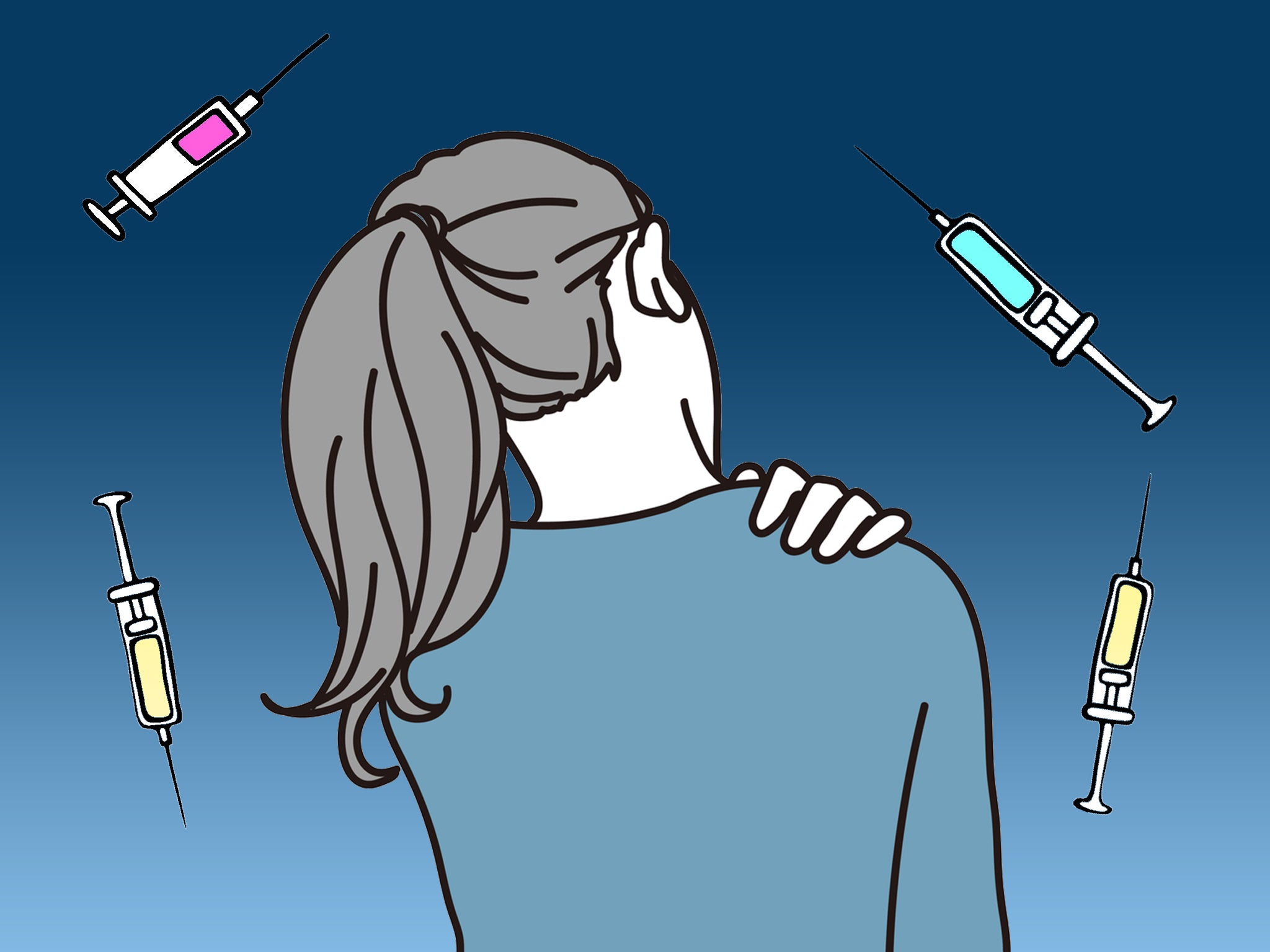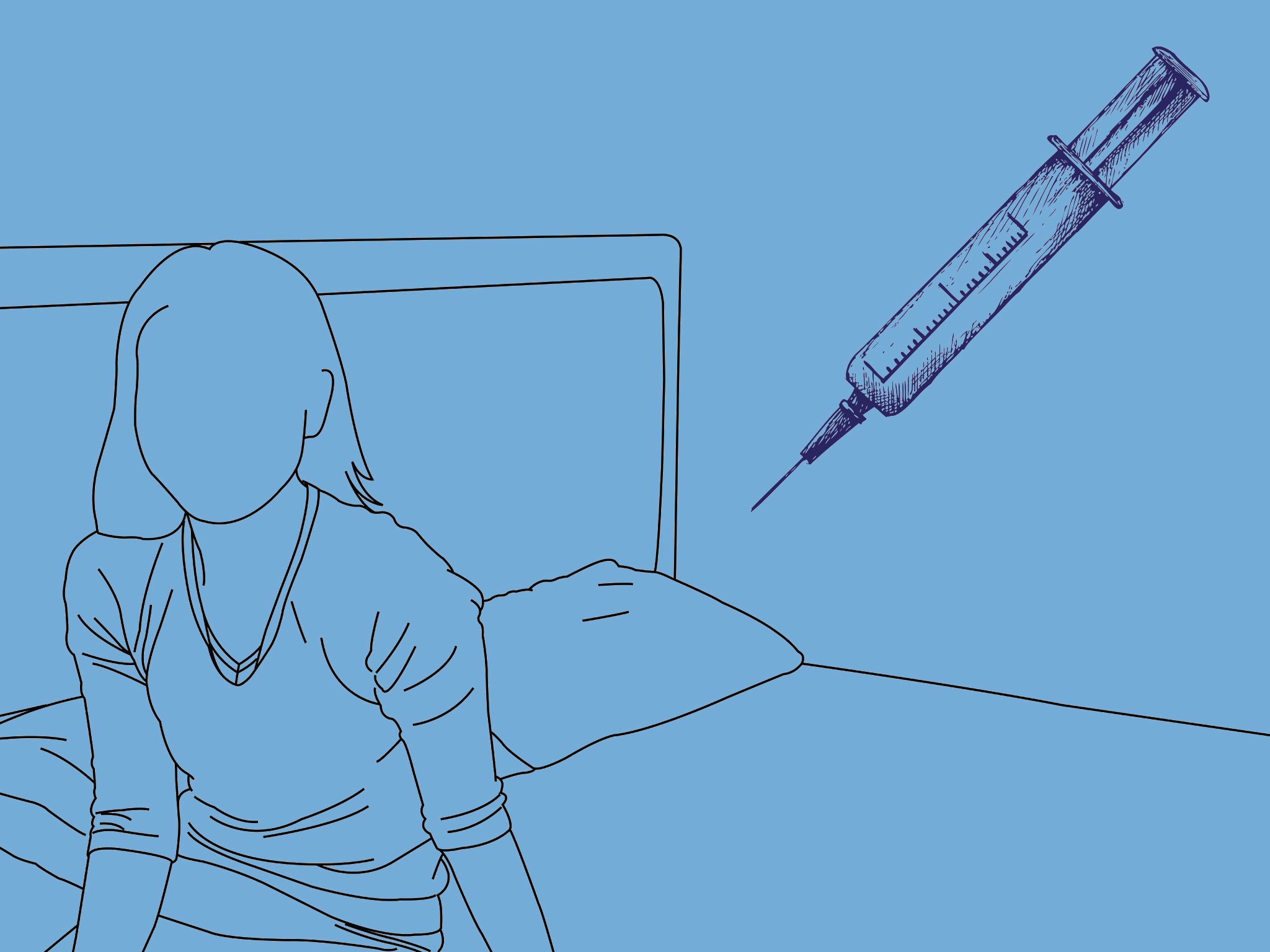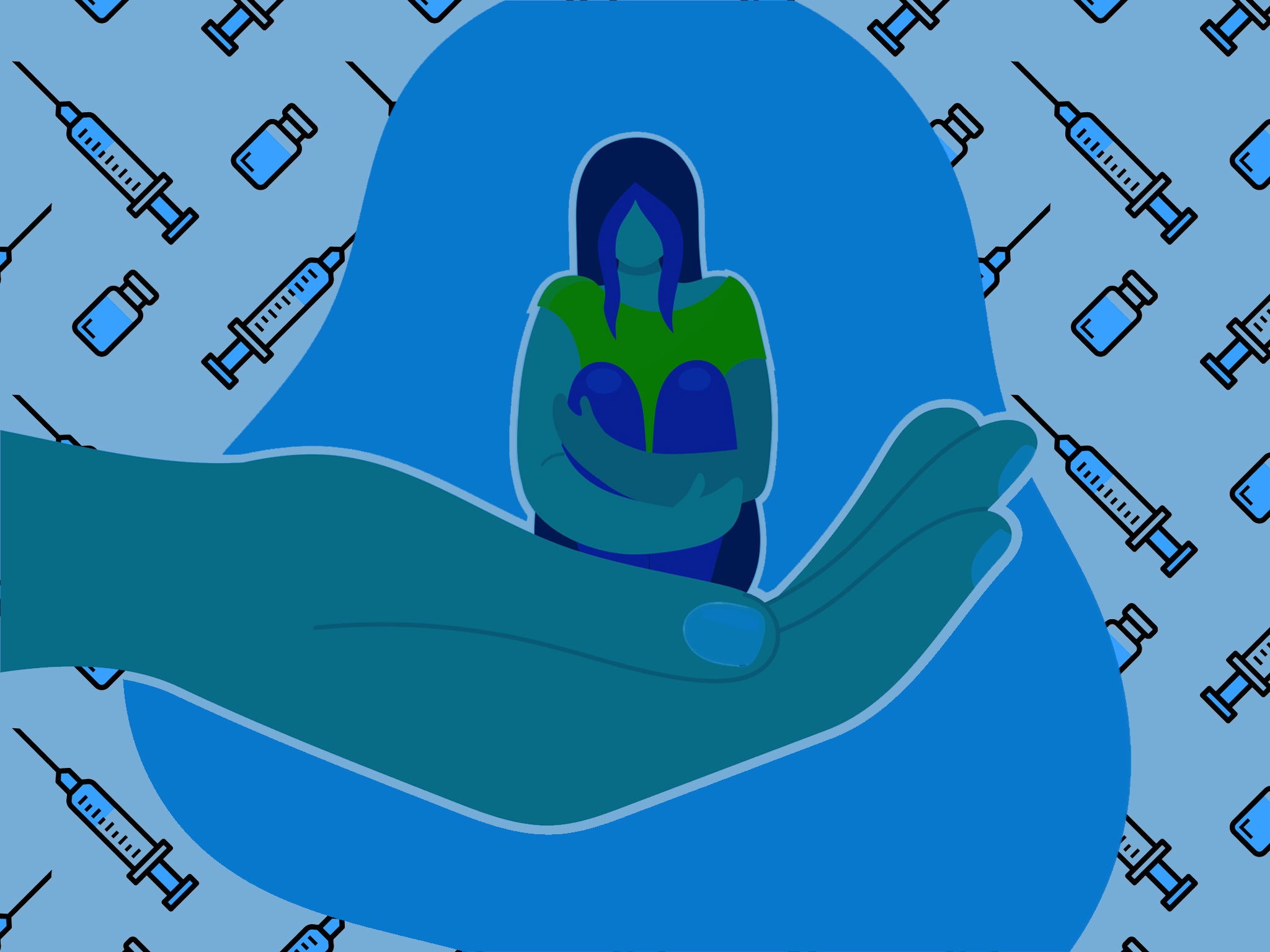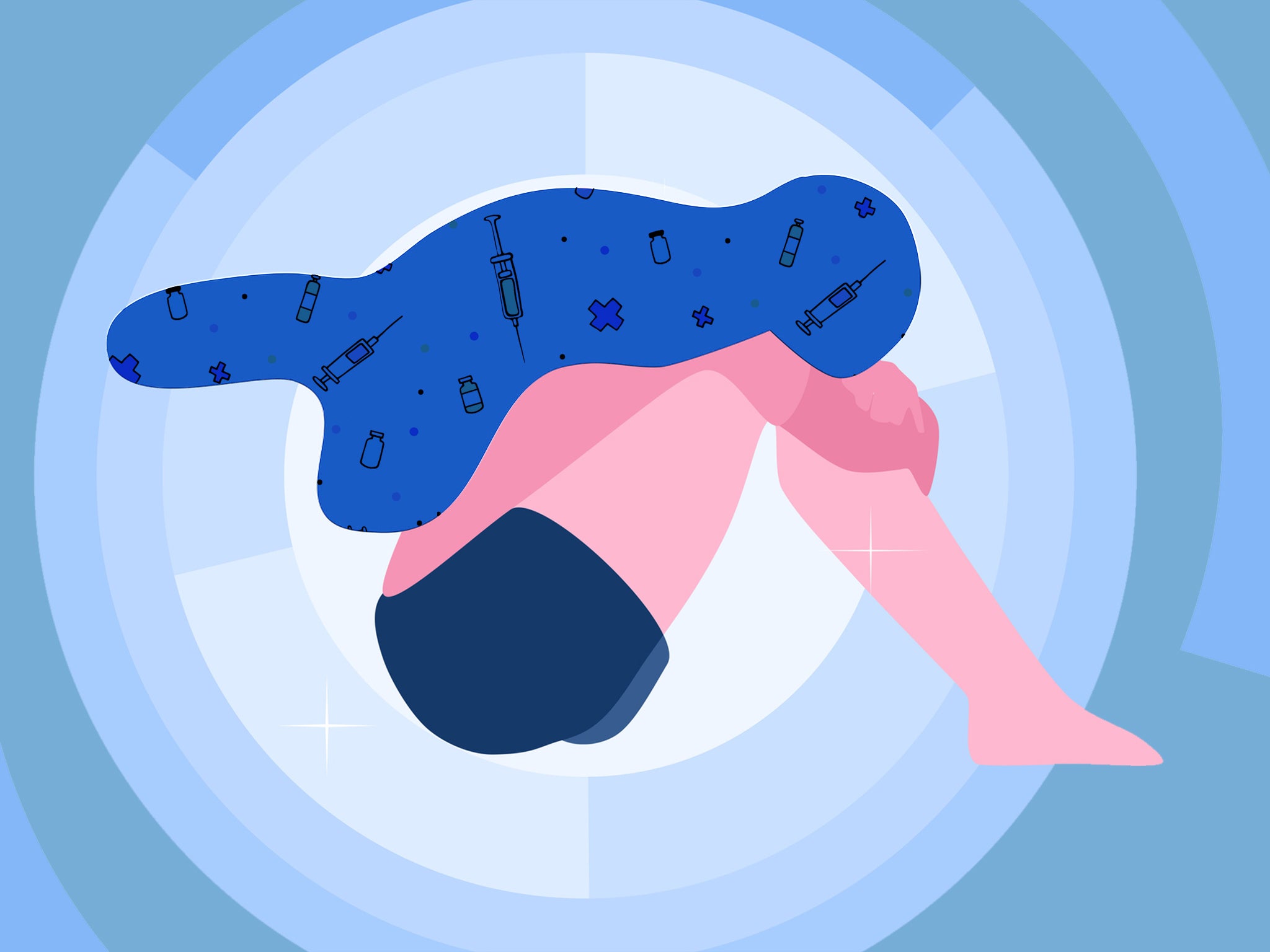Shocking numbers of women forcibly restrained with drugs in psychiatric units
‘I shouldn’t have been in there. Nobody should be in those places. It was traumatising. It felt like I was being done for murder or something,’ Vicky tells Maya Oppenheim


It is fair to say psychiatric units are places shrouded in secrecy, which remain a mystery to people outside their walls. As such, many Britons would be profoundly shocked to learn of the punitive, inhumane practices which take place inside psychiatric wards up and down the country. Patients who deviate from the stringent rules in such places are dealt with harshly and sometimes brutally by staff. Being violently restrained by multiple members of staff to be forcibly injected with powerful medication or being isolated in seclusion rooms are just some of the routine practices.
More shockingly, the data shows that women in psychiatric units are significantly more likely than men to have chemicals forcibly injected while being restrained by staff. NHS data, exclusively shared with The Independent, paints a terrifying picture of the situation between October 2020 to February 2021. The figures, shared by Dr Jessica Taylor, reveal the NHS carries out thousands of forced chemical restraints on individuals each month, but 63 per cent of all of those chemical restraints are used on women.
Dr Taylor, a psychologist who explores the issue in her new book Sexy but Psycho, notes that girls under the age of 18 receive the highest number of chemical restraints of all age groups and genders. While the proportion of men and women in the services was found to be virtually equal, Taylor’s analysis of the data demonstrates that girls and women under the age of 34 are forced to endure 64 per cent of all chemical restraints.
Meanwhile, girls younger than 18 were found to have been chemically restrained an average of five times per month, a substantially higher figure than boys of the same age, who were chemically restrained an average of twice each month. To put this into context, the feminist author, who examines the pathologisation of women in mental health settings in her research, found girls under the age of 18 made up 20 per cent of all chemical restraints on females, while boys younger than 18 constituted only 3 per cent of all chemical restraints on males.
Vicky, who did not want her surname used, has first-hand experience of being chemically restrained. The 28-year-old, who is from Durham in northeast England, was restrained and injected with drugs against her will three times while she was in a mental health facility in the north of England for around two months between the end of 2020 and early 2021. “It was a distressing environment,” she says. “It was the worst experience of my life. It took me a very long time to open up about it.”

Vicky was diagnosed with a borderline personality disorder and post-traumatic stress disorder (PTSD) at a young age due to suffering serious abuse during her childhood – but she was highly adept at keeping her mental health issues hidden from view. After she stopped taking her antidepressants, the “voices” in her head got worse and she tried to kill herself.
In the end, it was her next-door neighbour who found her collapsed after she tried to kill herself. She was rushed to Darlington Hospital where she stayed for a couple of nights to recover. Vicky explains she was then told she could be taken to a psychiatric unit anywhere in England as a result of being sectioned. Struggling for money and finding it hard to pay her bills, she initially thought it might be a good option, but how wrong her initial assumptions turned out to be.
“It wasn’t until the second they started ripping my bags apart that I thought, what the hell is going on?” Vicky recalls. “They were taking things off me like razors. I had my phone taken off me. I didn’t get it back for a few weeks until I had a visitor. That drove me up the wall. My phone is my security.”
Even to go for a cup of tea, they come with you. To get a spoon out you have to get a member to unlock the door. It literally felt like you were in there because you had done a crime but it was that you were poorly and needed help
She said being trapped inside the psychiatric ward resulted in her mental health massively deteriorating. She said the place changed her from being a “kind, caring person” to being easily annoyed and frustrated. “Everywhere you went in that building, the nurses came with you,” Vicky recalls. “Even if you went to wee. They wait outside the toilet. When you went to bed at night, they sat on a chair outside. The chair was wedged in the door frame all night and they rotate between nurses. I wasn’t a risk to anyone so I didn’t need someone to sit there all night watching me. It brought back my childhood trauma.”
Casting her mind back to her childhood, she said she reported the abuse she suffered from her family, who she is no longer in touch with, to the police, but at age 15 she was too old to be put into care. Vicky explains she was not alone in being perpetually scrutinised by staff – other patients were also being watched. She was not allowed outside for fresh air in the grounds even though she offered to be supervised while she did so.
“Even to go for a cup of tea, they come with you,” she recalls. “To get a spoon you have to get a member to unlock the door. It literally felt like you were in there because you had done a crime but it was that you were poorly and needed help. I shouldn’t have been in there. Nobody should be in those places. It was traumatising. It felt like I was being done for murder or something.”
Forced chemical restraints are traumatic: you are pinned down by up to six people. We are talking girls aged 12, 13 and 14. Why are they being injected? What is the impact on the health at that age?
But it was the restraint she endured that was particularly distressing. The first incident happened in “a whirlwind” in a corridor over the “littlest thing”. Vicky said she refused to take her sleeping pills one day. This quickly turned into her “fisting the walls screaming” because they were trying to force-feed her sleeping pills late at night. She said the doctor was insistent she needed sleeping pills called zopiclone but she felt this wasn’t right. She wanted to be taught coping mechanisms instead.
“After I refused to take them, they put the tablets in a small white container, so I knocked it out of their hands,” Vicky, who now works with Mind, a leading mental health charity, explains. “The two nurses literally grabbed me by the top of my arms so my back was facing the wall. By this time I was kicking. I was trying to pull myself away. They dropped me to the floor. Another two nurses grabbed hold of my legs. It was horrific. I had two nurses on my legs, two on my arms and one holding my head. They knocked my hearing aids out. I couldn’t hear anything. That was very disturbing.”
She said everyone could see what was happening and she felt highly embarrassed. Vicky recalled the nurses restrained her on the floor, with her lying on her back. She said the experience of having her hearing aids knocked out has left her with the ongoing fear that someone will knock out an aid when they hug her. “All I felt was a needle go in my arm,” Vicky recalls of the incident. “I had no idea what was happening to me. That drowsed me.”
You are on the bed and you can’t move and you can’t talk and you can’t fight anyone off. It is a feeling of almost being locked in your own body
Vicky said she was restrained for similar reasons during the other two incidents – noting she still has a mark on her arm from an injury she obtained during a chemical restraint which has made her too embarrassed to take off her jacket at work. In her view, the source of the problem lies in the fact that staff don’t have the right training. She argues that it is the fault of the system rather than the individual nurses.
She said she was in a much happier place now but her time inside the psychiatric unit still has a huge impact on her life and not a night goes by where she does not close her eyes and think about her time there. “I needed coping mechanisms not to be chucked on the floor,” Vicky says. “I needed people to listen to me.”
Taylor, previously a senior lecturer in Forensic and Criminological Psychology at the University of Derby, who carried out the research on forced chemical restraints, said it was difficult to pinpoint exactly why women are so disproportionately affected by the issue but she imagines it is linked to sexism. “It is a question of what would lead to that other than misogyny,” she tells The Independent. “Forced chemical restraints are traumatic: you are pinned down by up to six people. We are talking girls aged 12, 13 and 14. Why are they being injected? What is the impact on the health at that age?”
Taylor said being forcibly injected with a powerful tranquiliser has a fairly instantaneous effect because the injection often includes benzodiazepine – a sedative that slows down the body, but which experts warn is harder to come off than heroin. “You are on the bed and you can’t move and you can’t talk and you can’t fight anyone off,” Taylor adds. “It is a feeling of almost being locked in your own body.”

The psychologist argues that the disproportionate levels of forced tranquilisation being conducted on women could be linked to the fact male anger and agitation is seen as more socially acceptable and normalised than women’s indignation. When women become enraged, they are pathologised and their fury is deemed to be part of psychosis, she added, noting the gender disparity makes even less sense when you consider the majority of attacks on NHS staff are perpetrated by men. Taylor says that staff are more likely to use other methods to soothe men in psychiatric units – such as taking them into a room to calm down.
Taylor adds that when women and girls tell her they have been sectioned they learn to comply with the rules, due to it being very “dangerous” if they do not. “Girls and women are often in these psychiatric mental health wards because of severe trauma,” Taylor adds. “Pinning them down with a tranq arguably compounds the trauma. My question to a psychiatrist is, if you are repeatedly traumatising that girl with forced tranquilisation, how can you argue she has a mental health issue? If her mental health is getting worse, it is because you keep repeatedly pinning her to the floor.”
The psychologist said one woman had recently told her she was sexually assaulted several times by another patient when she was tranquilised. “She physically couldn’t move,” Taylor explains. “She couldn’t talk either. There is no point reporting it because nobody will believe you as you are under tranquilisation – they will think you dreamt it or were hallucinating.”
Taylor’s book states women and girls are seven times more likely to be given a borderline personality disorder diagnosis than men and boys, while women are also more likely to be diagnosed with anxiety, depression, panic disorder, phobias, suicidal thoughts and attempts to kill themselves, PTSD and eating disorders.
If you are repeatedly traumatising that girl with forced tranquilisation, how can you argue she has a mental health issue? If her mental health is getting worse, it is because you keep repeatedly pinning her to the floor
Lucy McKay, a spokesperson for Inquest, a leading charity that looks into state-related deaths, notes that the fresh data on the gender disparity of forced chemical restraints is “further evidence” of how mental health services cease to “safely and effectively support young women and girls, at shocking rates”. McKay, whose organisation examines deaths in mental health settings, police custody, prisons and immigration centres, went on to warn poor mental health is spiralling out of control into a “crisis” situation in the UK.
“And it is clear staff are reliant on chemical restraint rather than de-escalation,” she chips in. “There is also a lack of access to care which might prevent these crises in the first place. Young women and girls in mental health settings are often already dealing with significant trauma, which these incidents only add to. The Mental Health Use of Force Act, known as Seni’s Law, passed in 2018 and is intended to reduce and ultimately prevent the harmful use of restraint like this. It has now belatedly commenced, and we hope will challenge the continued harmful practices highlighted by this data.”
Seni’s Law was introduced in 2018 to curb the use of restraint in mental health settings. The law is named after Olaseni Lewis, a 23-year-old British man, who died in 2010 at Bethlem Royal Hospital in London after six police officers restrained him for more than 30 minutes using “excessive” force. Lewis had voluntarily accessed support and care after suffering from mental health problems. The young man passed away three days after the restraint took place.

John Read, one of the UK’s experts in forced psychiatric treatment, was first introduced to the practice of forced restraint while working as a nursing attendant in psychiatric units. “My interest started after watching people being unnecessarily restrained,” he explains. “It is traumatising for everyone. Including the staff.”
When asked about the data showing the gender gap in forced chemical restraints, Dr Read, a professor at the University of East London who worked as a clinical psychologist for almost 20 years, said he was “genuinely shocked”. Something which rarely happens to him, he adds. “Most of the violent incidents in psychiatric units involve males – like in society – so this is extraordinarily alarming,” he says. “I don’t have an explanation. Like everyone else, I assumed it would be the other way round. I am shocked and surprised. I would say this needs an urgent government investigation. It is absolutely appalling.”
He said these drugs should not be used on those who are younger than 18 under any circumstances due to them being highly powerful with potentially damaging repercussions for the patient. Read said that sometimes antipsychotic drugs are forcibly injected into patients but people do not want to take them as they have such extreme side effects.
“Staff aren’t properly trained to de-escalate potentially violent situations,” he adds. “A lot of research has been done showing it massively reduces the use of forced medication if staff are properly trained with aggressive situations. This is a systemic issue. Staff are overworked. If you are understaffed and quite frightened, you are going to resort to force and violence.”
After sharing the data on forced chemical restraints, an NHS spokesperson said they are “committed” to curbing the use of “restrictive practices, including chemical restraint” in all types of mental health services, noting there are specific schemes to tackle the issue.
“Ensuring that patients get the right mental health care that best meets their needs in the community is a priority for the NHS, and since 2015 the number of people in inpatient services has reduced by nearly a third,” the representative added.
Read adds that forcible tranquilisation via restraint is “re-traumatising” for women in psychiatric units because they became “emotionally disturbed” after experiencing abuse and violence.
“Rather than helping these men and women address what is disturbing them, which is often trauma, adverse experiences, violence and rape, we diagnose them with an imaginary mental illness and then medicate them. It is unsurprising that people in psychiatric hospitals get even more distressed. Nobody is listening to what they need. People lose control and become very angry. There is an imbalance in the training of psychiatrists – they are too geared to medicating and labelling, and there is insufficient attention to issues of trauma.”


Join our commenting forum
Join thought-provoking conversations, follow other Independent readers and see their replies
Comments